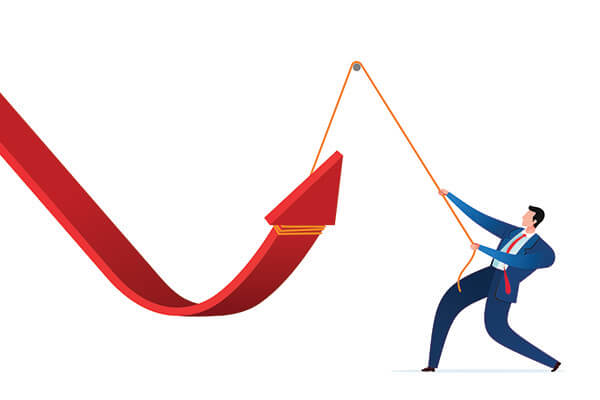Retailers can survive and thrive in an economic downturn if they retool their operations well in advance of a slump. Here are the critical steps you need to take
 When will the next recession hit? No one knows, but retailers are aware the decade-long run of good times can’t last forever. Two-thirds of the nation’s chief financial officers expect the United States to tip into an economic downturn by the third quarter of 2020, according to a Duke University/CFO Global Business Outlook survey.
When will the next recession hit? No one knows, but retailers are aware the decade-long run of good times can’t last forever. Two-thirds of the nation’s chief financial officers expect the United States to tip into an economic downturn by the third quarter of 2020, according to a Duke University/CFO Global Business Outlook survey.
Reasons? Some experts cite potential triggers as disparate as a serious U.S.-China rift, an interest rate misstep by the Federal Reserve, growing levels of corporate debt and the ballooning federal deficit. Any one factor might tip the economy into a recession — loosely defined as a significant drop in economic activity lasting more than two consecutive quarters.
Lemon to lemonade
Whatever its cause, a recession is bound to pose bottom line challenges. Can the pain be lessened? Yes, if you take certain steps to retool your retail operations in advance of the slowdown. And the time to start those steps, the experts say, is now.
“Churchill said ‘never waste a crisis,’ ” says John McQuaig, managing partner for McQuaig & Welk, a Wenatchee, Washington-based management consulting firm. “His advice is just as relevant when it comes to preparing for one. Don’t waste the time that still remains before the arrival of the next recession.”
Waiting too long is risky. “Shooting from the hip in a downturn often leads to business decisions that are compromises or worse,” says Michael Asbury, founder of Elevate Coaching and Consulting in Trinity, North Carolina. “Unprepared retailers are left with fewer options when tough times arrive, and those options are usually bad ones.”
Early steps to retool your business can return rich dividends in the form of a stronger bottom line long before the recession actually hits. And once the economic downturn does begin, your lean and mean machine can beat the competition.
“With the right preparation, an economic downturn can be more of an opportunity than a problem,” says Lisa Anderson, president of LMA Consulting Group, with headquarters in Claremont, California. “While less capable retailers fall by the wayside, your own business can expand its customer base.”
Bonus tip: Businesses that prepare for a recession tend to pull ahead during and after the slowdown, according an April 2019 report in the Harvard Business Review.
Plan for growth
So, what do you do, exactly? Above all, avoid the common mistake of undisciplined cost cutting.
“Focus on expanding your business — not on just cutting back,” says Cliff Ennico, an attorney and business consultant based in Fairfield, Connecticut. As you approach a recession, strengthen your market position by developing initiatives to win new customers.
Selling more to your existing market — and expanding it — need not be expensive. You likely can ferret out new ways to get more from your current organizational structure. Further, rationalizing your current resources often translates into a reduction of expenses.
“Every business suffers from costly fat that tends to grow over the years, especially during long periods of growth,” McQuaig says. “Now is the time to identify where your people are wasting their efforts and how your operations can be made more efficient. Is an entrenched bureaucracy, for example, slowing your customer response time?”
Rationalizing your operations can unleash unrealized potential. “Most businesses have a lot more capacity than they realize,” Asbury says. Unlocking efficiencies will help shorten your backlog and allow you to process orders more quickly. At the same time, he says, you can become a more reliable supplier: “Your on-time delivery and quality can cultivate loyal repeat customers.”
Here’s another way to increase capacity: Leverage the digital revolution. A 2018 Harvard Business Review study found that successful companies tend to use funds from reduced operating budgets to invest in productivity-
boosting technology.
But wait: Isn’t a recession on-ramp the wrong place to increase spending? Not if it results in a more profitable operation, McQuaig says. “Doubling down may seem counterintuitive, but it can be the best way to prepare for an economic slowdown.”
Bonus tip: Remember the adage, “You can’t cut your way out of a recession.”
Trim inventory
Excess inventory is a drag on profits any time. In a recession, it can spark failure.
“I have seen more stores go out of business because of bloated inventory than anything else,” says James E. Dion, president of Dionco Inc., a Chicago-based retail consulting firm. “If you’re not careful, your inventory can sit around for months until it has no value and consumers are tired of looking at it.”
Managing inventory through technology is a lot easier today than before. But the human factor also can play a big role: Experts advise making a special effort with vendors. Make sure you are getting all the discounts to which you are entitled. But also make your loyalty known.
“If you do not have good relationships with your supply chain, start today to improve them,” says Daniel Feiman, managing director of Build It Backwards, a consulting firm in Redondo Beach, California. “It will help you reach a critical goal: managing the inventory you need rather than the inventory you have.”
Avoid the temptation to overbuy. “Never buy more than you need to get a lower price,” Dion says. “Vendors may offer free shipping, for example, if you buy a certain minimum.” Turn the offer down if it will result in bloated inventory. “Buy only what you need and are comfortable selling,” he says.
At the same time, buying more from fewer suppliers can be a smart way to foster good relations. “Many independent retailers buy a few items from each of a large number of suppliers,” says Bob Phibbs, a retail consultant based in Coxsackie, New York. “But they do not enjoy any priority treatment that way. It’s better to patronize fewer vendors and do more business with each of them.”
Finally, let your suppliers help with inventory control. “The more information you can feed to your suppliers about rates of sale the better,” Dion says. “Give them your point-of-sale data. When they get information about drop-offs in demand, they are better able to react and offer some inventory balancing, return and exchange of products. There can be a lot of opportunities if you treat your suppliers as partners rather than adversaries.”
Bonus tip: Reduce obsolete inventory now. Waiting until the recession hits
will increase the bottom line impact.
Serve the new customer
The modern consumer is acquiring merchandise differently from previous generations. How do you adapt your store to meet changing needs?
Serving the millennial means moving to mobile. “Millennials are not paying attention to traditional marketing, such as loyalty programs,” Dion says. “Their heads are in their phones. You need to ask, ‘How is my mobile exposure reaching this consumer? Have I invested in a robust mobile site?’ ”
Success means more than adapting an old website to mobile. “The real Holy Grail is a purpose-built app that offers something special,” Dion says. “Maybe you can schedule services right on the app; maybe it can quickly and efficiently offer information vital to the end user.” Think service, Dion says: “Millennials are into ‘do it for me.’ ”
Millennials also haunt social media. “You need a social media presence, especially on Facebook,” Phibbs says. “There is no other social media platform as powerful as Facebook. It attracts people from different generations and allows for private groups. Remember that a lot of people become aware of brands through their friends.”
Bonus tip: Millennials love games, so your mobile app should offer one. For example, maybe the shopper can earn points in trivia quizzes.
Control cash flow
A recession can send a retailer’s normal revenue rhythms into a tailspin. “My first concern for any business anticipating a downturn is the smart management of cash flow,” Feiman says. “Start to monitor more closely what is coming in and going out. Are turns slowing? Is your cash being locked up for longer periods?”
Make accounts receivable top of mind. “Use your aging reports proactively, not reactively,” Feiman says. “When receivables start to become stale, communicate early with customers. If there’s an issue, resolve it.”
When good customers start slowing their payments, you want to respond in a way that avoids alienating them. Keeping on top of the problem will require good communication skills. “Call and ask the customer if there is any problem,” Ennico suggests. “You might say something like ‘I know times are tough. Are you hurting?’ If the customer is experiencing a temporary problem, your loyalty to them can pay off down the line. “If you help customers now, they will stick with you forever,” he says.
Cash is a two-way street. Monitor how quickly funds flow out, as well as come in. The goal is to stay liquid. “If you have cash, you have options,” Feiman says. “If you run out of cash, you are out of business.” Don’t just rely on financial statements that look backward, he says. “Use cash budgets that look forward.”
Bonus tip: Remember Feiman’s basic rule: “Collect an old receivable before making a new one.”
Trim fixed costs
While you’re monitoring those cash currents, consider your variable and fixed costs. The former tend to be related directly to business activity, and there is often little fat to be trimmed. It’s the second that often holds the most promise. Identify discretionary expenses that can be cut.
“You really have to watch fixed costs such as lease payments, depreciation and building-related expenses,” McQuaig says. Many companies over the past decade have succumbed to the temptation to increase fixed costs in anticipation of higher revenues, he adds. “The problem is that those costs will not change very fast as your income starts to go down. In a declining market, fixed costs tend to eat into the bottom line.”
Cutting fixed costs can spark dramatic increases in profit, Asbury says. “If you can increase your sales while holding fixed expenses constant, a good portion of the increased revenues will flow straight to the bottom line,” he says.
Even if certain fixed costs can’t be cut overnight, starting the thinking process early can pay off later. “You might not be able to shrink your physical space this month,” says McQuaig, giving one example. “But now might be a good time to plan a possible reduction two years down the road.”
Bonus tip: Cut variable costs by retooling your procedures to more closely meet customers’ needs.
Secure working capital
If cash is king, working capital is the heir apparent. You need enough reserve financial capability to tide you over during a cash flow squeeze. One way to do that is to trim your outstanding debt. “The best thing you can do now is pay off your credit lines,” Ennico says. “Have them ready as cash reserves in case you need them down the road.”
Again, an early start pays rich dividends. Arrange for any additional credit lines while the economy and your business still are in good shape. “The time to negotiate with banks is when you don’t need them,” Ennico says.
If having sufficient reserve capital is a requisite for success, so is an appropriate debt structure. “If you have expensive short-term borrowings against long-term assets, you might want to negotiate longer term debt,” McQuaig says. “The lower payments will help you work your way through softening revenues if operations shrink. You can always accelerate payments down the road, but you cannot decelerate them.”
You might be able to take other steps to clean your balance sheet. Examples: Can a significant portion of short-term debt be restructured through a 10-year Small Business Administration-backed loan, resulting in smaller monthly payments? Can your straight line of credit be made less expensive by turning it into one secured by accounts receivable?
Bonus tip: Postpone major initiatives unless they promise to generate timely significant revenue.
Diversify funding sources
Time also is of the essence when it comes to long-term debt. Banks hold their cash tighter when recessions begin. “It is easier to borrow now, when banks can see you have healthy cash flows,” McQuaig says. “The situation is far different when your income starts to drop. Waiting too long to apply for loans gets a lot of businesses in trouble.”
Make sure you are on solid ground with your primary funding source. “Now is a good time to have a conversation with your banker,” Feiman says. “Ask questions such as, ‘What if a recession hits? What if I need a little more working capital? What do you need from me today to preapprove that?’ If you give your banker enough time, just about anything can be worked out. But if you run into the bank at the last minute for financing, the story is far different.”
No matter how secure you are with your main bank, have plan B ready to go. “You want to cultivate a secondary financing relationship,” Feiman says. “Tell the institution you will not be making them your primary source today, but you want to start a relationship that leads to their stepping up to the plate, if and when they are needed. Consider starting a small account to encourage their commitment.”
Trimming unproductive fixed costs and wasteful expenses both are great ideas. But avoid the common temptation to short-change marketing.
“While you need to be careful and strategic in what you spend, promotion and advertising and growth-related initiatives are mandatory, even before and during a recession,” says Joel G. Block, president of Bullseye Capital, a management consultancy in Agoura Hills, California. “If you neglect them, your business will not continue to grow. You will potentially shrink into oblivion.”
Bonus tip: Sell unneeded assets now, using the cash to pay down debt and reduce leverage.
Retool and recharge
While no one is happy when the economy softens, a downturn can serve
to reveal opportunities for making your business stronger and more profitable. Turn hard times into an advantage.
“View the recession as an opportunity, not a threat,” Ennico says. “Take the time now to ask how you can expand your business when the downturn arrives, even though you will not be making as fat a margin. What are the services and businesses you can get into without too much change? How can you show current and new customers you are willing to better meet their needs?”
Above all, be flexible.
“Good businesses make money in good times and bad,” Ennico says. “While there is no recession-proof business, the winners are those who adapt best to challenging conditions.”
Enlist Your Employees
 Make recession-busting a team effort. Push your business into third gear by enlisting the energies and ideas of your employees.
Make recession-busting a team effort. Push your business into third gear by enlisting the energies and ideas of your employees.
“When it comes to personnel, the biggest downside is a lack of communication,” says Lisa Anderson, president of LMA Consulting Group in Claremont, California. “Keep your employees in the loop by letting them know that economists are predicting a recession. But rather than causing panic by casting the economic downturn as a bad thing, present it as an opportunity to gain market share by spending more time with shoppers, solving their problems and convincing them your store will be around while competing suppliers fall by the wayside.”
Brainstorming with your staff can uncover hidden treasures. “Employees have a vital perspective on the market because they are so close to customers,” says Daniel Feiman, managing director of Build It Backwards, a consulting firm headquartered in Redondo Beach, California. “Encourage them to speak up with their ideas.”
This also is a good time to build flexibility and agility into your workforce. “Cross-train skills so you can move people around in response to unanticipated shifts in the workload when the recession arrives,” Anderson says. “And also consider utilizing temporary labor to fill in the gaps, performing any work duties you are not sure will carry into the future.”
Resist the temptation to trim the workforce too deeply when hard times arrive. “While cost cutting can be important when preparing for a recession, try to keep your trained workforce in place,” says John McQuaig, managing partner of McQuaig & Welk, a Wenatchee, Washington-based management consulting firm. “Many times companies cut their staffs too deeply, then cannot recover after a recession because skilled workers are not in place to regenerate revenue.”
Bonus tip: When a recession hits, eschew morale-busting layoffs in favor of more productive, labor-saving adjustments such as hour reductions, furloughs, part-time positions and performance pay.
 Phillip M. Perry, an award-winning writer who has published widely in the fields of business management, workplace psychology and employment law, is syndicated in scores of magazines nationwide. He can be reached at phil@pmperry.com.
Phillip M. Perry, an award-winning writer who has published widely in the fields of business management, workplace psychology and employment law, is syndicated in scores of magazines nationwide. He can be reached at phil@pmperry.com.

